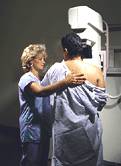
THURSDAY, Jan. 26 (HealthDay News) — The number of Americans being screened for colon, breast and cervical cancers still fall below national targets, federal health officials said Thursday.
In 2010, 72.4 percent of women were being screened for breast cancer, below the target of 81 percent, for cervical cancer it was 83 percent of women, while the target is 93 percent, and for colon cancer 58.6 percent of Americans were screened, missing the target of 70.5 percent, according to the U.S. Centers for Disease Control and Prevention.
“Not all Americans are getting the recommended screening for breast, cervical and colorectal cancer,” said report co-author Mary C. White, branch chief of the CDC’s Division of Cancer Prevention and Control. “There continue to be disparities for certain populations.”
The screening rates are particularly low among Asians and Hispanics, according to the report in the Jan. 27 issue of Morbidity and Mortality Weekly Report.
Among Asians, the screening rate for breast cancer was 64.1 percent, for cervical cancer it was 75.4 percent, and for colon cancer it was 46.9 percent.
Hispanics were less likely than non-Hispanics to have screening for cervical and colon cancer (78.7 percent and 46.5 percent, respectively), the researchers found.
Screening is important, said Dr. Stephanie Bernik, chief of surgical oncology at Lenox Hill Hospital in New York City.
“Screening saves lives,” she said. “When you catch a cancer at a smaller size it does affect outcome.”
Some people may be confused about screening, because different medical groups have different screening protocols, Bernik said.
“It’s hard to get people to do screening in general. People look for any excuse not to get screened. When they see there is a controversy about when to start screening, they look at it as an opportunity to not do the test,” she said.
Bernik also admits that screening can result in some over-treatment.
“With screening comes that risk,” she said. “Unfortunately, we are not at a point where we can select the patients that are not going to have a problem, so we treat everyone equally. So, there is a little bit of over-treatment but, overall, you are improving survival for many people.”
The U.S. Preventive Services Task Force recommends that women aged 50 to 74 get a mammogram every two years to screen for breast cancer.
Women aged 21 to 65, or those who have been sexually active for three years, should have a Pap test to screen for cervical cancer at least every three years, the task force recommends.
For colorectal cancer, men and women aged 50 to 75 should be screened with a yearly fecal occult blood test or sigmoidoscopy every five years, or have a colonoscopy every 10 years.
Other highlights of the report include:
- Breast cancer screening rates remained stable from 2000-2010, varying only about 3 percent.
- Colon cancer screening rates increased from 2000-2010, to more than 58 percent for both men and women.
- Cervical cancer screening rates dipped 3.3 percent from 2000-2010.
- Screening rates for all these cancers was much lower among the uninsured or those who didn’t have a regular doctor.
The Affordable Care Act is expected to lower these barriers to access by expanding insurance coverage, the authors said.
“Other efforts are needed, such as developing systems that identify persons eligible for cancer screening tests, actively encouraging the use of screening tests, and monitoring participation to improve screening rates,” the authors added.
More information
For more on cancer screening, visit the U.S. Centers for Disease Control and Prevention.

